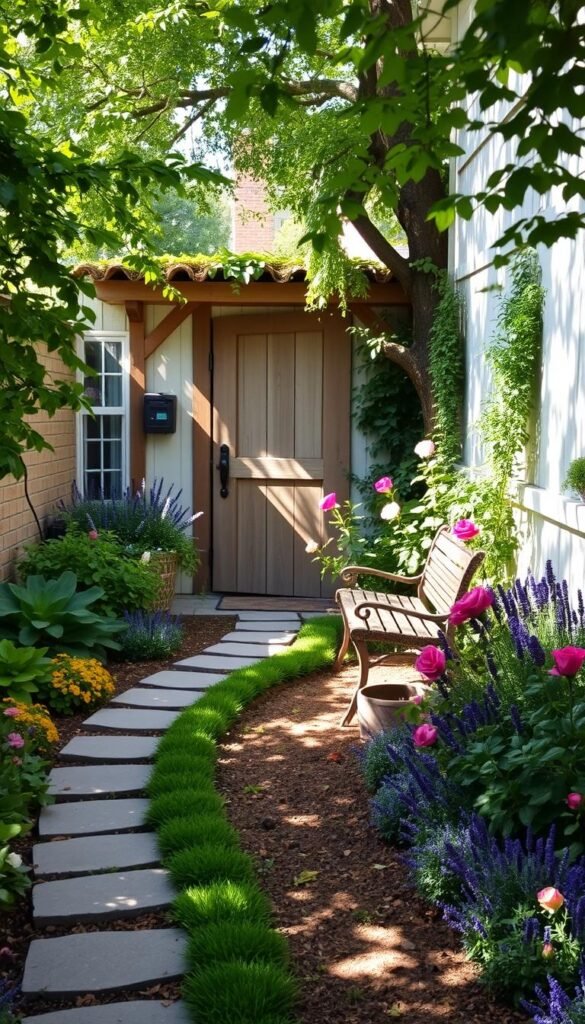Your home’s exterior sets the tone for what’s inside, and even the coziest outdoor space can leave a lasting impression. With smart design choices, you can turn limited square footage into a vibrant entryway that feels both inviting and uniquely yours.
Thoughtful layouts make all the difference when working with compact areas. Curved pathways lined with mulch or stones guide visitors while adding texture, and vertical elements like climbing vines draw the eye upward. These tricks create depth without overwhelming the space.
Low-maintenance solutions keep your yard looking fresh year-round. Mix evergreen shrubs with seasonal blooms for color that lasts. Strategic edging defines planting zones, and rocks or gravel reduce weeds—giving you more time to enjoy your oasis.
For a touch of whimsy, blend rustic charm with modern simplicity. A cottagecore aesthetic thrives in petite plots through wildflowers and weathered decor, proving magic thrives in small packages. Layer heights and textures to make every inch count, transforming your entrance into a dynamic showcase.
Ready to reimagine your outdoor canvas? Let’s explore how clever details can elevate curb appeal and turn your threshold into a story worth telling.
Designing Your Dream Front Garden Entrance
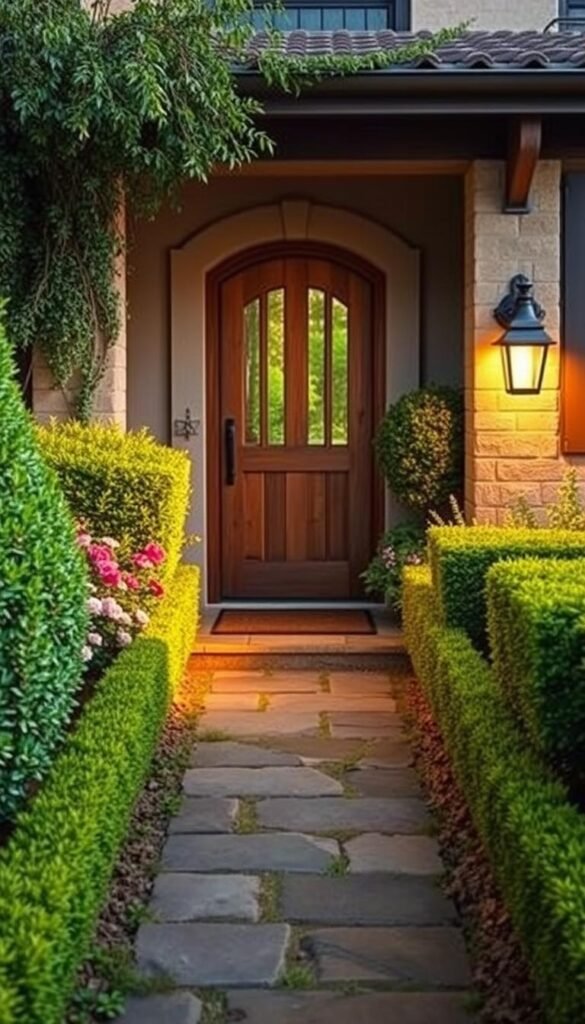
The path to your front door tells a story before guests step inside. Start by choosing walkway materials that mirror your house’s character—like irregular bluestone paired with crisp brick borders. This combo adds rustic charm while creating clean lines that guide visitors naturally.
Balance is key when arranging plants along your entryway. Frame the left side with vertical accents like clematis climbing a lamp post, then ground the space with low-growing juniper. On the right, lamb’s ear and dwarf shasta daisies offer soft textures that contrast with bold barberry shrubs.
Mix heights and bloom times for nonstop appeal:
- Birch trees or crape myrtles add airy vertical structure
- Carpet roses deliver summer color near pathways
- Evergreen laurels ensure winter greenery
Background plantings like camellias and sweetspire shrubs create depth without crowding your outdoor space. They soften property lines while letting sunlight filter through—perfect for maintaining an open feel. With thoughtful layering, every season brings new reasons to admire your porch approach.
Creative Small Front Garden Ideas for a Welcoming Entrance
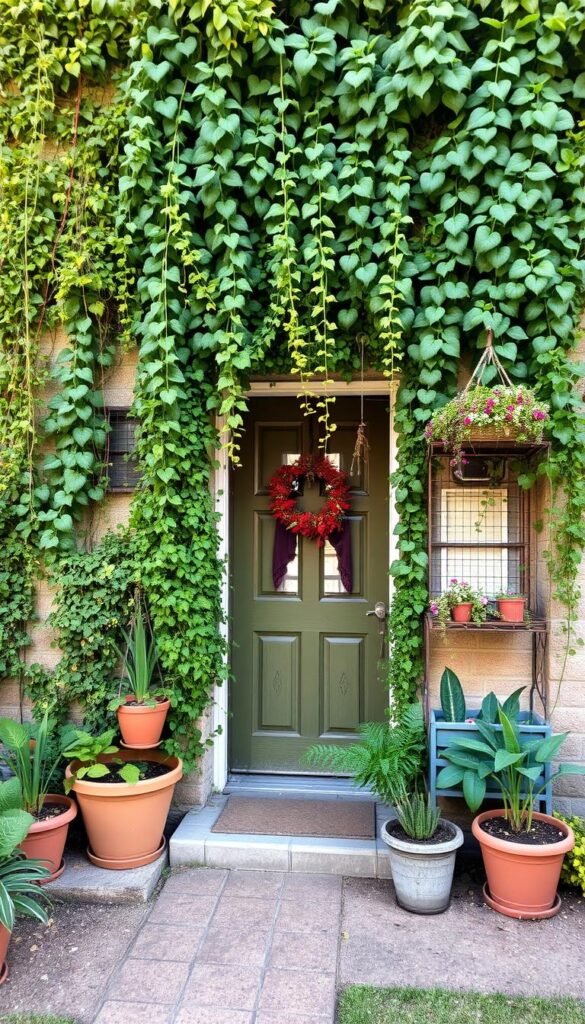
Transform your entryway into a lush retreat without needing acres of space. Vertical gardening turns walls into living art—try wall-mounted planters filled with trailing ivy or compact herbs. These space-savers add depth while keeping walkways clear.
Group plants strategically to trick the eye. Place tall grasses near entryways and low-growing sedum by steps. This layering effect makes tight areas feel expansive. Use containers in varying sizes to create rhythm—a mix of terra-cotta pots and metal troughs works beautifully.
| Vertical Element | Best Plants | Space Saved |
|---|---|---|
| Wall Planters | Succulents, Ferns | Up to 4 sq ft |
| Trellis System | Clematis, Jasmine | 6-8 sq ft |
| Hanging Baskets | Petunias, Strawberries | 3 sq ft |
Pathways become design features when edged with colorful heuchera or dwarf boxwoods. Add solar lanterns along borders for evening charm. These touches guide visitors while showcasing your style.
Rotate seasonal accents in key spots—pansies in spring, mums in fall. This keeps your yard landscaping ideas fresh without major overhauls. A single statement piece, like a bubbling fountain, anchors the space without clutter.
Ready to rework your front yard? These approaches prove even modest areas can deliver big impact. Continue reading to explore pathway designs that elevate curb appeal further.
Maximizing Curb Appeal with Front Yard Landscaping

Your property’s first impression begins at the street view. Strategic design choices can elevate your exterior from ordinary to extraordinary, blending functionality with showstopping style.
Using Statement Pathways and Pavers
Stone pavers redefine walkways by merging durability with timeless elegance. Choose irregular slate pieces for rustic charm or geometric concrete slabs for modern flair. These materials frame your lawn while guiding guests to your door with intention.
Pair pathways with mulch beds to amplify contrast. A 3-inch layer of dark hardwood chips makes flowering plants pop while:
- Blocking weed growth
- Retaining soil moisture
- Defining curved garden edges
| Paver Type | Best For | Maintenance |
|---|---|---|
| Bluestone | Traditional homes | Low |
| Brick | Cottage styles | Moderate |
| Porcelain | Contemporary designs | None |
Integrating Colorful Planter Boxes
Elevate tight spaces with cedar or metal boxes bursting with petunias or ornamental kale. Place them flanking steps or beneath windows to draw the eye upward. Rotate seasonal blooms for year-round vibrancy without digging up your lawn.
Pro tip: Match planter hues to your front door color. This subtle coordination creates visual flow across your yard landscaping ideas, making the entire property feel intentionally designed.
Choosing the Perfect Garden Bed and Planting Strategy
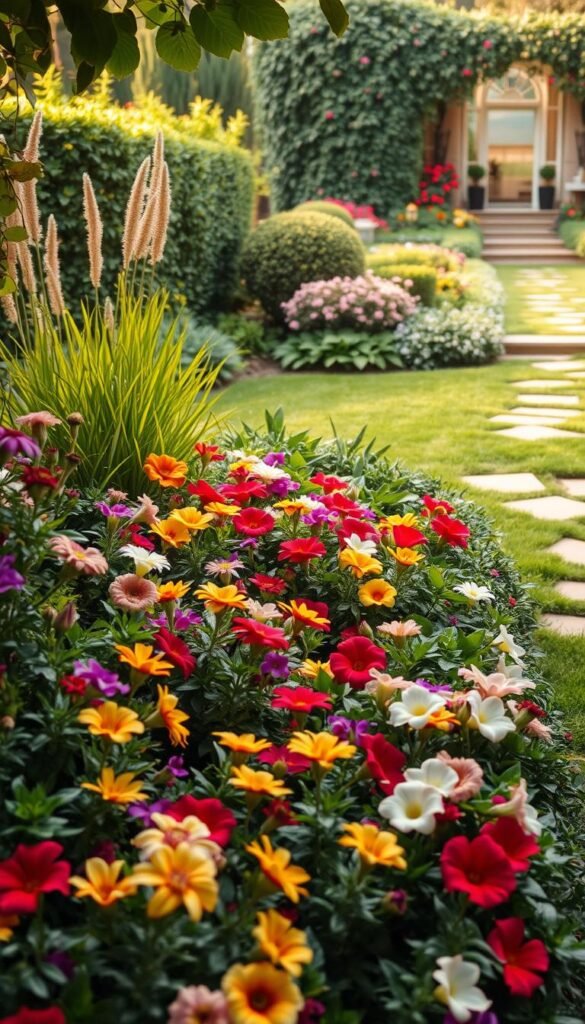
Creating a thriving garden starts with smart bed selection and plant pairings that work in harmony. Raised garden beds shine here—they improve drainage and skip the backbreaking soil prep of traditional plots. Perfect for patios, front yards, or snug corners, these structures let you grow everything from hydrangeas to fresh herbs with ease.
Selecting Suitable Plants and Flowers
Mix textures and bloom times for nonstop visual interest. ‘Endless Summer’ hydrangeas deliver months of color, while ornamental trees like Japanese maples add vertical drama. Underplant with hostas for lush foliage in shady spots.
Sun-loving perennials like coneflowers and daisies thrive in raised beds, needing minimal care. Pair them with spiky liatris for contrast. Ground covers like pachysandra weave through beds, hiding bare soil while suppressing weeds.
| Plant Type | Sun Needs | Bloom Period |
|---|---|---|
| Hydrangea | Partial Shade | Summer-Fall |
| Coneflower | Full Sun | June-September |
| Hosta | Shade | Foliage Focus |
| Boxwood | Any | Year-Round |
Clip boxwood hedges into crisp borders that frame your space without crowding. Layer phlox and creeping thyme along bed edges for soft transitions. This approach keeps your home’s entrance inviting through all seasons.
Ready to dig deeper? Continue reading to explore how raised beds and vertical elements maximize small yards.
Incorporating Raised Beds and Vertical Garden Elements
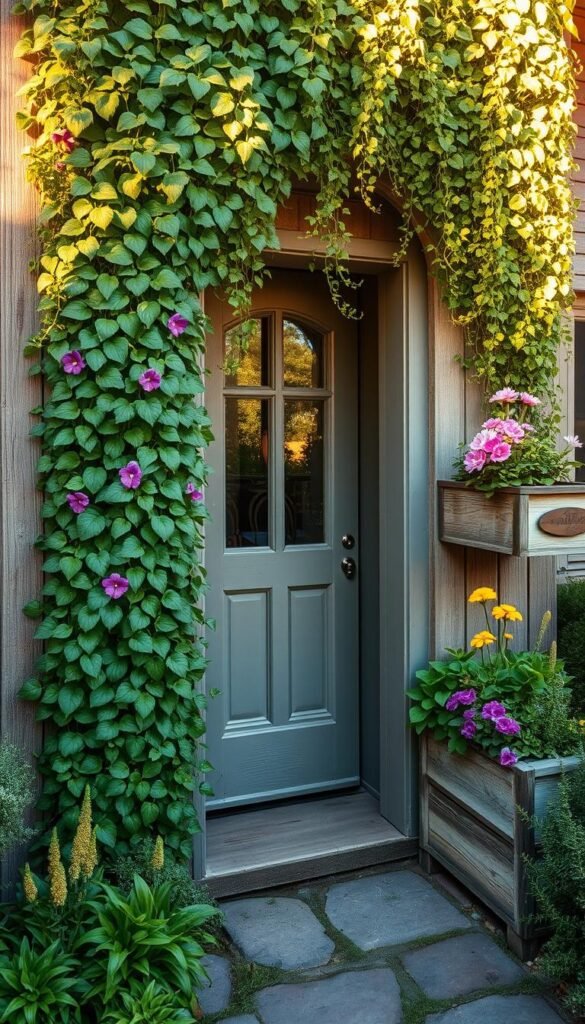
Compact outdoor areas thrive when you think upward and layered. Raised beds and vertical systems let you multiply planting opportunities while keeping pathways clear and functional.
Why Raised Beds Shine in Tight Quarters
Elevated planters solve drainage issues and eliminate knee-straining ground work. They’re perfect for patios or sloped yards where traditional planting fails. A 24-inch height lets roots breathe while deterring pests.
Place these beds anywhere:
- Flank garage walls with herb boxes
- Create a mini orchard in driveway strips
- Frame entry stairs with cascading flowers
“Vertical gardens turn blank walls into blooming masterpieces – no square footage wasted.”
Crafting Living Walls That Work
Transform fences into floral tapestries using climbing vines or modular systems. The Florafelt Pro System uses drought-smart plants like Aeonium ‘Pinwheel’ that thrive with minimal water. Its grid design ensures even coverage as foliage matures.
| Vertical System | Ideal Plants | Water Needs |
|---|---|---|
| Pocket Planters | Strawberries, Herbs | Daily |
| Trellis Grid | Clematis, Jasmine | 2-3x Weekly |
| Living Wall Panel | Sedum, Moss | Weekly |
Pair raised beds with vertical accents to create depth. Russian vines cloak pergolas while lamium spills from elevated planters. This combo makes petite yards feel expansive through strategic layering.
Continue reading to explore how containers add final flourishes to your green oasis.
Enhancing Visual Appeal with Terra-Cotta Pots and Containers
Terra-cotta pots bring timeless character to any outdoor space. Their earthy tones blend seamlessly with greenery, creating warmth that welcomes guests before they reach your door. These planters excel in small areas, letting you arrange herbs or flowers vertically without overwhelming limited square footage.
Group pots in tiered displays for instant visual impact. Place trailing plants like ivy in upper tiers and bold blooms like geraniums below. This layered approach adds depth, making your garden feel lush even in compact settings. For a burst of color, mix petunias and marigolds in varying pot sizes.
Drought-tolerant options thrive in terra-cotta’s porous material. Succulents and lavender stay healthy with quick-drying soil, reducing maintenance. Rotate seasonal plants to keep your home’s entrance vibrant year-round—think pansies in spring and ornamental kale for winter.
Pro tip: Cluster three pots near entry steps—tall, medium, and short—to guide the eye upward. Pair with decorative stones or solar lights for evening charm. These simple touches transform basic planters into a cohesive design statement.

